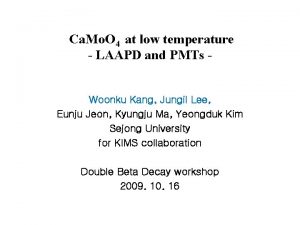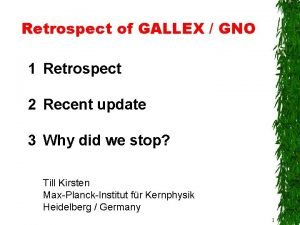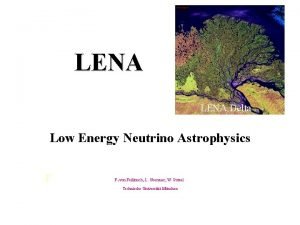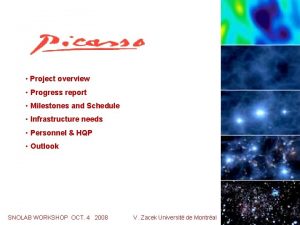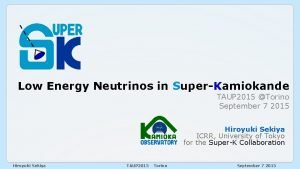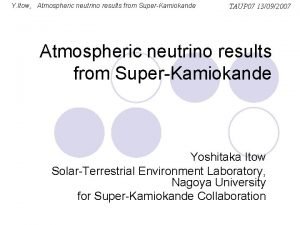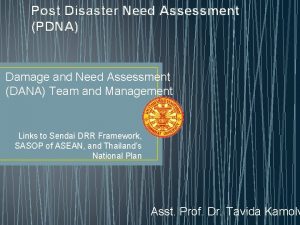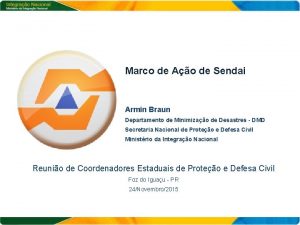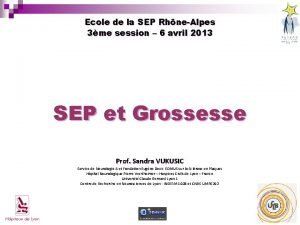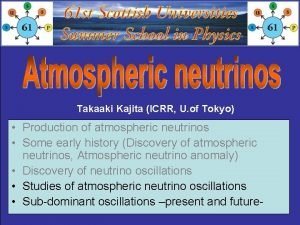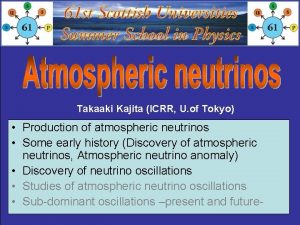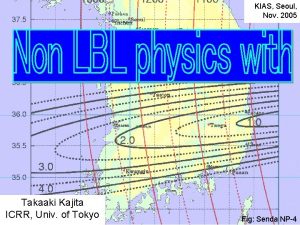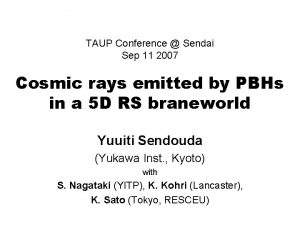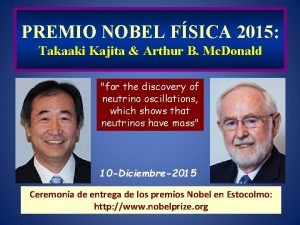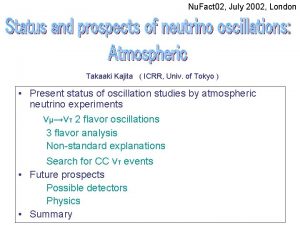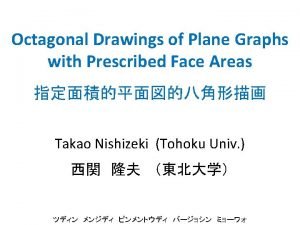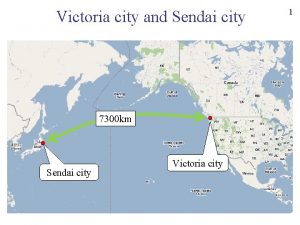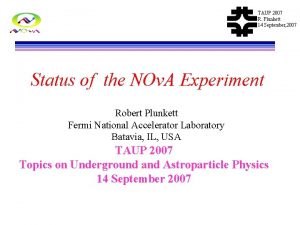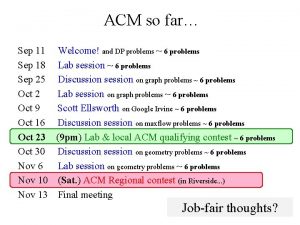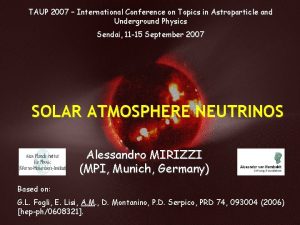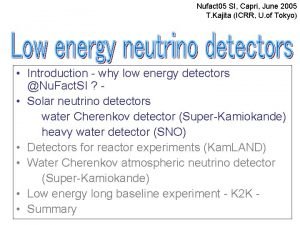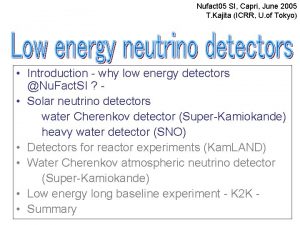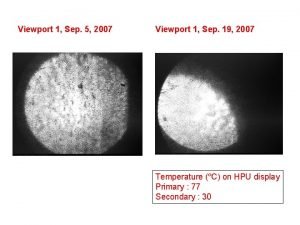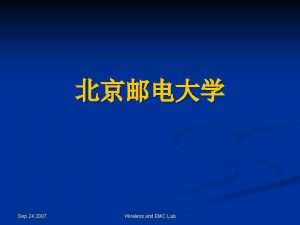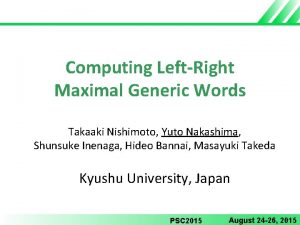TAUP 07 Sep 2007 Sendai Takaaki Kajita ICRR


















- Slides: 18

TAUP 07, Sep. 2007, Sendai Takaaki Kajita, ICRR, Univ. of Tokyo ◆Introduction ◆T 2 KK @TAUP 05 ◆Updating T 2 KK - L dependence, - Higher energy option, - Octant of q 23, ◆Summary

sin 2 q 12, sin 22 q 23, Dm 122, |=Dm 232|・・・・ Already measured. Let’s assume that non-zero q 13 will be observed by the next generation oscillation experiments. n 3 q 13 ne nm nt Sign of Dm 232 If q 23 ≠p/4, is it >p/4 or <p/4 ? n 3 n 2 n 1 ne nm nt or CP ? n 3 How much will Kamioka-Korea 2 detector setup (T 2 KK) contribute to these measurements?


Possible experimental setup 0. 27 Mton 2. 5 deg. off axis (or smaller off-axis Angle) 0. 27 Mton 2. 5 deg. off axis Distance from the target (km) JPARC 075 4 MW 2. 5 deg. off-axis beam @Kamioka Off-axis angle Fig. from Senda NP 04

Osc. probability in Kamioka and Korea sin 22 q 13=0. 05 BG & efficiency: almost identical both 2. 5 deg. off axis beam

Expected sensitivity hep-ph/0504026 Total mass of the detectors = 0. 54 Mton fid. mass 4 years neutrino beam + 4 years anti-neutrino beam Mass hierarchy 3 (thick) 2 (thin) CP violation (sind≠ 0)


Update (1) - 1050 km: a special baseline ? K. Okumura, 2 nd T 2 KK workshop, Seoul 2006 2. 5 degree off-axis beam with L between 1000 km and 1250 km is available. sin 22 q 13 Checked if the sensitivity depends strongly on the baseline length. Sensitivity to mass hierarchy (True = normal hierarchy) d The sensitivity does not depend strongly on L !

Update (2): higher energy option Motivation: Mass hierarchy ar. Xiv: 0705. 4396 3 (black) 3 (thick) T 2 KK ‘s sensitivity on mass hierarchy is still limited compared with the US studies… Higher energy better ?

Flux (arb. unit) Higher energy beam Energy Dependent Maximum Likelihood Analysis P(nm ne) 1. 0 to 2. 5 degree off axis beam available in Korea. En (Ge. V)

Signal and BG for various off-axis beams Korea Kamioka 2. 5 degree signal 1. 0 degree signal BG BG sin 2(2 q 13)=0. 1 d=1/2 p 4 year neutrino run 4 MW beam 2. 0 degree Smaller off-axis angle: Low E BG more serious. (2 nd osc. Max. difficult to see. ) But larger matter effect at the 1 st osc. Max. . 1. 5 degree 2. 5 degree

3 s sensitivities for various OA angles Mass hierarchy CP violation F. Dufour, 2 nd T 2 KK workshop, July 2006, Seoul (Updated) Pre lim 3 Kam only (OA 2. 5) Kam + Korea OA 1. 0 Kam + Korea OA 1. 5 Kam + Korea OA 2. 0 Kam + Korea OA 2. 5 Mass hierarchy: OA 1. 0 @Korea gives the best sensitivity CP violation: Sensitivity depends weekly on the beam option ina ry Could be slightly too optimistic for OA angle less than 2. 5 degrees (The syst errors are assumed to be fully correlated between 2 detectors)

Update (3): Octant ambiguity of q 23 In the previous study, maximal q 23 mixing (q 23=p/4) was assumed. However, q 23 might not be p/4. In this case, there should be additional ambiguity in the parameter measurements (especially in that of sin 2 q 13) due to the ambiguity in the octant of q 23 (i. e. , q 23 >45 or <45 deg. ). It will be very nice if the same setup can solve the octant ambiguity of q 23. Resolving 8 fold parameter degeneracy in T 2 KK

Oscillation probabilities and the signal P(nm ne) by the solar Dm 2 is proportional to sin 22 q 12 ・cos 2 q Atm. + CP terms 23 Solar oscillation effect visible in a very long baseline (or very large L/E) experiment. BG events Solar term sin 22 q 12・cos 2 q 23 effect visible ○sin 2 q 23 = 0. 4, sin 2 2 q 13 = 0. 01 ●sin 2 q 23 = 0. 6, sin 2 2 q 13 = 0. 0067 (sin 2 q 23・sin 22 q 13 is equal in the two cases. ) Dm 2: positive, d=p 3/4

Sensitivity to octant of q 23 OA 2. 5 degree for both Kamioka and Korea sin 22 q 13 sin 22 q 23=0. 96 sin 22 q 23=0. 99 hep-ph/0609286 2 3 Octant ambiguity of q 23 can be resolved at 2 if sin 22 q 23 < ~0. 97 (almost independent of the value of sin 22 q 13 and mass hierarchy). Could resolve the 8 hold degeneracy of the oscillation parameters.

Discussing T 2 KK more Sep. 30 and Oct. 1 Univ. of Tokyo Your participation and contribution are most welcome! http: //www-rccn. icrr. u-tokyo. ac. jp/workshop/T 2 KK 07/

• • If non-zero q 13 is observed…. We hope to proceed to the next phase of experiment with higher power beam and larger detector(s). Goals: discovery of leptonic CP violation, and determination of mass hierarchy and octant of q 23. (+ Various non-LBL physics). T 2 KK is one of the serious possibilities. We will continue the studies.

End
 Taup
Taup Taup
Taup Taup ff
Taup ff Taup
Taup Taup
Taup Taup
Taup Global risk assessment framework
Global risk assessment framework Sendai framework philippines
Sendai framework philippines Priority of sendai framework
Priority of sendai framework Marco de sendai
Marco de sendai Diferencia entre el marco de hyogo y sendai
Diferencia entre el marco de hyogo y sendai Priority of sendai framework
Priority of sendai framework Hyogo çerçeve planı
Hyogo çerçeve planı Yep 10
Yep 10 Mediateca de sendai
Mediateca de sendai 7 metas globales del marco de sendai
7 metas globales del marco de sendai Priority of sendai framework
Priority of sendai framework Sep ecole
Sep ecole Complejo pichanas
Complejo pichanas
